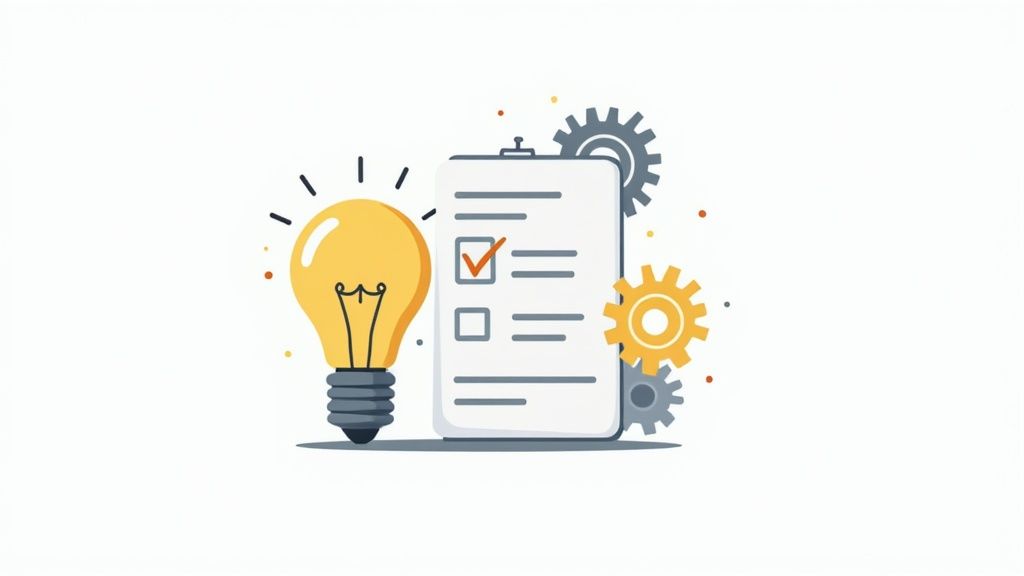
A3 Problem Solving Template: Drive Results Fast
Published
The Power Behind the A3 Problem-Solving Template
The A3 problem-solving template. An 11" x 17" sheet of paper designed to tackle complex problems. This seemingly simple tool has become a cornerstone of problem-solving in organizations worldwide. Born from Toyota’s lean manufacturing practices, the A3 template demonstrates how constraint can foster creative solutions. This structured approach consistently delivers results, providing a clear framework for effective problem-solving.
Instead of lengthy reports and drawn-out meetings, the A3 process encourages teams to consolidate their thinking onto a single, manageable document. This focused approach promotes deeper analysis and more effective brainstorming. Visual communication is key, using diagrams and charts to illustrate complex issues and monitor progress. The A3 template also fosters collaboration by providing a shared space for teams to document their thoughts and contribute to solutions.

The A3 problem-solving template emerged from Toyota's lean manufacturing system in the 1960s and has since become a staple of continuous improvement efforts globally. By standardizing problem-solving on a single 11" x 17" sheet, Toyota saw a 30-50% reduction in decision-making cycles on its production lines. Surveys of large-scale manufacturers indicate that organizations using A3 templates report 15-25% faster resolution times for complex operational problems compared to less structured methods. The Plan-Do-Check-Act (PDCA) cycle, integrated within the template, creates a four-stage iterative process that improves solution sustainability. Some automotive sector reports show a 20% decrease in recurring problems after implementing the A3 methodology. Learn more about the history and impact of A3 templates: A3 Template History. This structured approach guides teams through a logical flow, from problem identification to solution implementation and evaluation.
Why A3 Continues to Outperform
The A3 methodology’s enduring strength lies in its adaptability. Organizations are successfully applying this time-tested technique to modern challenges, leveraging its effective critical thinking framework. This adaptability allows the template to transcend specific industries or problem types. Whether tackling operational issues in manufacturing or enhancing patient care in healthcare, the A3’s core principles remain highly relevant.
A flexible, tool-agnostic mindset is equally important. This approach prioritizes people and their problem-solving skills over strict adherence to any single tool. Check out our guide on finding the right role for you: Read also: Influencer Marketing Jobs. While the A3 template provides a valuable framework, it is the collaborative effort and critical thinking of the team that ultimately drives success. This balance between structure and flexibility is what makes the A3 template a powerful tool for continuous improvement.
Breaking Down the A3 Template: What Actually Works
Beyond the theory, what makes an A3 problem-solving template truly effective? It's about fostering a mindset of focused, collaborative problem-solving. Let's explore the key components that drive results and how successful practitioners use them.
Crafting a Compelling Problem Statement
The problem statement acts as a compass for the entire A3 process. A vague problem leads to wasted effort and ineffective solutions. Effective problem statements are concise, measurable, and actionable, focusing on the gap between the current and desired states. For example, instead of "Sales are down," a better statement is "Sales are down 15% compared to Q1 of last year, impacting profitability by 10%."
Visualizing the Current Condition
Documenting the current condition involves revealing hidden patterns contributing to the problem. Visuals like flowcharts, graphs, and diagrams can illuminate these patterns. This stage should answer questions like "What are the key metrics?" and "What trends do they exhibit?"
Conducting Root Cause Analysis: Beyond the Symptoms
Root cause analysis uncovers the underlying reasons behind the problem. Techniques like the "5 Whys" and fishbone diagrams help teams delve deeper. This is where the A3 template shines, providing dedicated space for this crucial step.
To understand the components and their function within the A3 process, let’s take a look at the table below.
| Component | Purpose | Key Questions to Address | Best Practices |
|---|---|---|---|
| Problem Statement | Clearly defines the problem to be solved | What is the specific problem? How is it measured? What is the impact? | Use concise, measurable, and actionable language; focus on the gap between current and desired states |
| Current Condition Visualization | Visually represents the current state related to the problem | What are the key metrics? What trends are observed? What are the contributing factors? | Utilize charts, graphs, and diagrams to highlight patterns and insights |
| Root Cause Analysis | Identifies the underlying causes of the problem | Why is this happening? What are the root causes, not just symptoms? | Employ techniques like 5 Whys and fishbone diagrams; drill down to the core issues |
| Countermeasure Development | Develops solutions that address the root causes | What specific actions will address the root causes? How will these actions be measured? | Develop SMART (Specific, Measurable, Achievable, Relevant, Time-bound) countermeasures |
This table summarizes the core components of the A3 and how each contributes to effective problem-solving. By addressing the key questions and following best practices for each component, teams can ensure a thorough and impactful analysis.
Developing Effective Countermeasures
After identifying root causes, the next step is developing and implementing countermeasures. This is about sustainable solutions, not quick fixes. Effective countermeasures are specific, measurable, achievable, relevant, and time-bound (SMART).
Adapting the Template to Your Organization
While the A3 structure remains consistent, it can be adapted to suit different organizational contexts. The key is maintaining the core principles of focused problem-solving and visual communication.
Common Pitfalls and How to Avoid Them
Rushing the root cause analysis, focusing on symptoms, and neglecting key stakeholders can derail the A3 process. Being aware of these pitfalls is crucial for success.
Visualizing A3 Effectiveness: A Data-Driven Approach
The data chart below visualizes the impact of well-crafted A3 templates by comparing effective and ineffective implementation rates across key components.

The data chart demonstrates the positive correlation between effective implementation of A3 components, particularly the problem statement and root cause analysis (75% and 80% effective implementation rates, respectively) and successful outcomes. Conversely, ineffective implementation of current condition visualization (40%) can hinder progress. This underscores the importance of strong visuals. Investing time in each area increases the likelihood of achieving desired results.
Digital A3 Templates: Evolution or Revolution?
The A3 problem-solving template, once a staple physical document, has made its way into the digital world. This transition begs the question: is this shift an evolution or a revolution in problem-solving? This move to digital is changing how organizations work together and tackle challenges.

Overcoming Resistance to Digital
Initially, many organizations were hesitant to embrace digital A3 platforms. This reluctance stemmed from concerns about disrupting established processes and a perceived simplicity of using paper. However, leading companies are now showing that digital tools can actually improve, not hinder, the A3 process. For instance, real-time collaboration features enable team members in different locations to work together concurrently, speeding up the problem-solving process.
The Advantages of Digital A3s
Digital A3 problem-solving templates provide numerous benefits over their paper-based predecessors. Digital platforms enable real-time collaboration, removing geographical limitations. This feature is especially valuable for organizations with distributed teams. In addition, integrated data visualization tools allow for more effective root-cause analysis, offering deeper insights into complex issues. Imagine creating charts and graphs instantly within the template itself, improving clarity and supporting better decision-making. This is the power of the digital A3.
Digital A3 template adoption brings significant efficiency gains. In manufacturing, for example, administrative overhead for continuous improvement projects has been reduced by 40-60%. Cloud-based A3 tools have enabled real-time collaboration across multiple global sites for Fortune 500 manufacturers, cutting median project review times from 14 days to 72 hours. From 2018 to 2023, over 70% of A3 implementations in Europe and North America transitioned to digital formats. Integrated analytics have also improved root-cause identification accuracy by 35% through data visualization layers. Learn more about the benefits of digital A3 adoption: Find more detailed statistics here. This change aligns with the broader adoption of digital workflows in lean management, supporting millions of process improvement activities each month. You might also be interested in: How to master Influencer Marketing.
Building a Knowledge Repository
One of the most valuable benefits of digital A3 templates is the ability to create a searchable repository of completed A3s. This repository becomes an invaluable resource for addressing future challenges. This means organizations can capture and preserve institutional knowledge, even with staff changes or departmental restructuring. By archiving completed A3s, teams can easily access past solutions, best practices, and lessons learned, preventing wasted effort. This promotes a culture of continuous improvement, where knowledge is shared and expanded upon over time.
A3 in Healthcare: When Lives Depend on Solutions
Healthcare presents unique challenges. The inherent complexity of the systems, the diverse stakeholders, and the critical nature of patient care create a demanding environment. Within this landscape, the A3 problem-solving template offers a valuable tool for enhancing both patient safety and the overall quality of care. Hospitals and medical groups are increasingly adopting this straightforward yet powerful methodology to address intricate issues, leading to tangible improvements in various areas.
From Medication Errors to Surgical Complications: A3 in Action
Nursing teams, for example, are using the structured A3 thinking process to tackle medication errors. By clearly defining the problem, visually representing the current medication administration process, and performing a thorough root cause analysis, these teams can pinpoint systemic issues that contribute to errors. An A3 might uncover, for instance, communication breakdowns between nurses and pharmacists or flaws within the electronic prescribing system.
Additionally, surgical departments are leveraging the A3 to minimize complications through systematic process analysis. The A3 problem-solving template provides a structured format for documenting pre-operative procedures, identifying potential points of error, and developing countermeasures to mitigate those risks. This emphasis on process improvement leads to better patient outcomes and a safer surgical environment.
Hospital administrators also find the A3 helpful in addressing patient flow challenges, a persistent issue in busy hospital settings. Mapping patient journeys from admission to discharge on an A3 template visually highlights bottlenecks and inefficiencies within the system. This visual representation allows for focused interventions that can streamline patient flow and improve the patient experience.
A 2023 evaluation of healthcare quality improvement projects utilizing A3 methodologies revealed significant reliability in outcomes. Hospitals that implemented A3 templates experienced 18-30% faster cycle times for process improvements in areas such as medication reconciliation and surgical workflows. The structured documentation reduced ambiguity in cross-departmental collaborations, enabling teams to achieve over 90% consensus on problem definitions. The study also highlighted the robustness of the A3 process, demonstrating strong inter-rater reliability (Cohen's κ >0.75) when evaluating key components like root cause analysis. For more detailed statistics, refer to this resource: BMJ Quality & Safety.
Bridging Clinical Expertise and Improvement Science
Healthcare organizations are effectively bridging clinical expertise with improvement science using the A3. Understanding the clinical aspects of a problem is essential, but it's equally crucial for healthcare professionals to possess the tools and methods to analyze and solve problems systematically. The A3 provides a framework for integrating these two critical perspectives.
Adapting the A3 for Healthcare
While the core principles of the A3 remain consistent, healthcare organizations are adapting specific template components to maximize its effectiveness within their unique setting. They are incorporating elements such as human factors analysis and systems thinking to address the complex interactions between people and technology in healthcare. This nuanced approach enables more comprehensive problem-solving, ultimately leading to more effective and sustainable solutions. By adopting the A3 methodology, healthcare organizations are demonstrating a commitment to continuous improvement and a dedication to delivering the best possible patient care.
Creating Your First A3: A No-Nonsense Guide

Let's be honest – your first A3 problem-solving template probably won't be perfect. But it can be a powerful tool for improvement. This guide offers a practical, step-by-step approach to creating your first A3, using real-world examples and experiences.
Choosing The Right Problem For Your A3
Not all problems need an A3. This methodology works best for complex issues that need in-depth analysis and collaborative problem-solving. A quick fix might be enough for simple problems. But for recurring issues, problems with unknown causes, or those affecting many areas, an A3 provides the structure for a thorough investigation.
Crafting A Clear Problem Statement
A well-defined problem statement is essential. It's the foundation of your A3, guiding the entire problem-solving process. Keep it concise, measurable, and specific, clearly showing the gap between the current and desired state.
For example, instead of "Customer satisfaction is low," try something like: "Customer satisfaction scores dropped by 15% last quarter, mainly due to longer wait times." This provides a measurable target for improvement and points towards a potential area of focus.
Gathering Current State Data: Revealing Insights
Gathering current state data isn't about confirming what you already think. It's about uncovering the real picture. Use objective data and visuals, like charts and graphs, to illustrate the problem's trends and patterns. These visuals can reveal hidden insights you might otherwise miss.
Practical Root Cause Analysis
Root cause analysis can feel intimidating, but it doesn't need advanced statistical knowledge. Simple methods like the "5 Whys" can be surprisingly effective. Begin with your problem statement and repeatedly ask "why" until you find the root cause. This helps drill down past superficial symptoms and get to the core issues.
Developing Actionable Countermeasures
After identifying the root causes, develop countermeasures. These aren't quick fixes, but sustainable solutions addressing the underlying problems. Countermeasures should be SMART: Specific, Measurable, Achievable, Relevant, and Time-bound.
For instance, instead of "Improve training," a SMART countermeasure could be: "Implement a new training program for customer service reps by the end of Q2, focusing on active listening and cutting average handling time by 10%."
Learning From Examples: Successes And Failures
Learning from others is invaluable. Analyzing both successful and unsuccessful A3s offers valuable lessons. Examining what worked, what didn't, and the reasons behind those outcomes can help you avoid common mistakes and improve your own A3 practice.
A3 Implementation: Traditional Vs. Modern
The following table compares traditional and modern best practices for implementing the A3 problem-solving methodology.
| A3 Phase | Traditional Approach | Modern Best Practice | Common Mistakes | Success Indicators |
|---|---|---|---|---|
| Problem Definition | Often based on anecdotal evidence or limited data | Data-driven, using metrics and visualizations | Focusing on symptoms, not the root cause | Clearly defined, measurable problem statement |
| Current Condition | Descriptive narrative, limited visuals | Data visualization, process mapping, stakeholder interviews | Confirmation bias, insufficient data | Compelling visuals revealing patterns and trends |
| Root Cause Analysis | Basic "5 Whys," limited tools | Advanced root cause analysis tools, statistical analysis | Stopping at superficial causes | Identification of core issues driving the problem |
| Countermeasures | General actions, weak accountability | Specific, measurable actions with clear ownership | Lack of follow-up, failing to measure impact | Implemented solutions showing measurable improvement |
This table shows how modern approaches, using data analysis and advanced tools, can make each A3 phase more effective. You might be interested in: How to master Influencer Marketing and potentially find a career using the A3 methodology.
By following this guide and learning from real-world cases, you can use the A3 problem-solving template to drive real improvements in your organization. Even your first A3, although imperfect, can be a big step towards a culture of continuous improvement.
Building a Culture Where A3 Thinking Thrives
An A3 problem-solving template is just a piece of paper without the right organizational culture. Isolated successes won't create lasting change. Instead, a company must cultivate a culture of continuous improvement, making A3 thinking the standard practice.
Integrating A3 Into Daily Practices
Successful organizations integrate the A3 methodology into daily routines without creating extra paperwork. This might involve A3 discussions during weekly team meetings or using the template for project planning and review. The goal is to make A3 a natural part of the workflow, not an added task.
Developing Internal A3 Coaches
Like any skill, A3 thinking requires coaching and practice. Developing internal A3 coaches is vital for building proficiency. These coaches can mentor colleagues, give feedback on A3 templates, and promote the methodology across the organization. They become invaluable resources, ensuring consistent and effective application of A3 thinking.
Recognizing and Reinforcing A3 Behaviors
To truly embed A3 thinking, recognize and reward those who use it. This can be as simple as acknowledging a well-completed A3 in a team meeting or including A3 proficiency in performance reviews. Highlighting these behaviors shows employees that structured problem-solving is valued.
Overcoming Resistance to A3
Introducing a new method will likely face some resistance. Some might see A3 as just another temporary initiative, while others may find the structured approach challenging. Addressing these concerns directly is essential. Communicate the benefits of A3 clearly, provide sufficient training and support, and showcase the tangible results that A3 thinking can deliver. Successful A3 integration relies on addressing skepticism and building a shared understanding of its value.
Cultivating a Pro-A3 Environment
Creating a culture where A3 thrives requires a comprehensive approach. It involves providing the right tools and resources, fostering open communication, and allowing room for experimentation. This requires a mindset shift, viewing problems as opportunities for learning and improvement. In this environment, the A3 template becomes more than just a tool; it becomes a catalyst for ongoing growth.
Find the right role in a company that values structured problem-solving. Explore the available influencer marketing positions at Influencer Marketing Jobs. From entry-level to senior management, discover opportunities to advance your career and contribute to a thriving marketing landscape. Sign up for our weekly email list for personalized job recommendations based on your skills and interests.